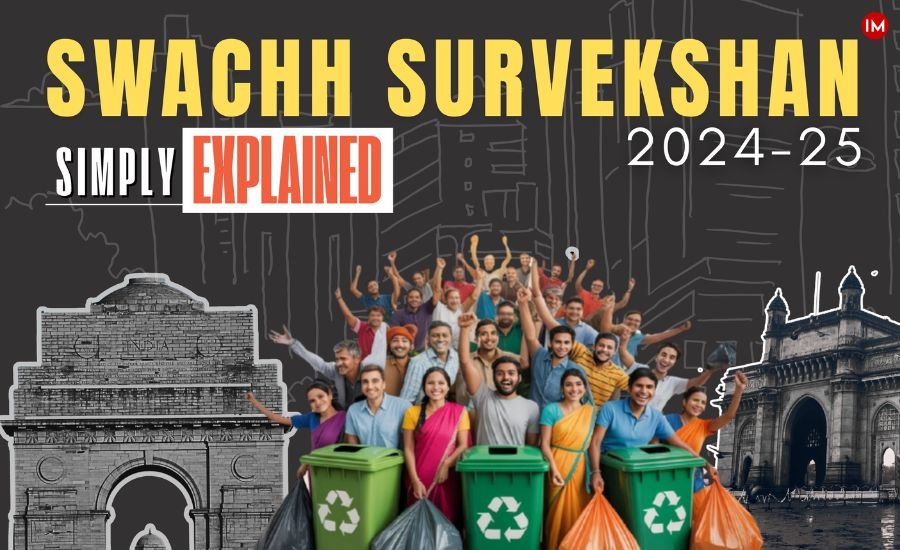
Indore didn’t just sweep its streets — it swept away landfills, turned garbage into fuel, and redefined what urban India can be.
On August 15, 2025, at a ceremony in New Delhi, President Droupadi Murmu announced the results of the Swachh Survekshan 2025 survey. For the eighth consecutive year, Indore topped the rankings as India’s cleanest city, ahead of Surat and Navi Mumbai.
The recognition is part of the Swachh Bharat Mission – Urban, which annually evaluates over 4,400 towns and cities on cleanliness, waste management, and sanitation.
Indore’s success was not a surprise. It was the outcome of a decade-long developmental program where the Indore Municipal Corporation (IMC), the Madhya Pradesh government, and its 40 lakh citizens worked together to create a waste-to-wealth model admired across the country.
Timeline of Indore’s Cleanliness Journey
Indore’s transformation was gradual but consistent.
- 2016 – Swachh Bharat Mission intensifies; IMC begins overhaul.
- 2017 – Indore wins Swachh Survekshan for the first time.
- 2018–2019 – Legacy waste clearance starts at Devguradia landfill.
- 2020 – City achieves 100% door-to-door waste collection and segregation.
- 2022 – Asia’s largest Bio-CNG plant inaugurated.
- 2025 – Indore wins its eighth consecutive award, becoming India’s first zero-landfill city.
What the Government Did: Building the Indore Model
The Indore Municipal Corporation launched 100% door-to-door collection of household waste to 4.3 lakh households, made segregation at source compulsory, and tracked 850 GPS-fitted vehicles in real time. It provided tax rebates for compliance and fines for default.
The government of Madhya Pradesh made an investment in the Bio-CNG plant (2022), facilitated landfill clearing, and subsidized composting and recycling. The system was made stronger with public-private partnerships, and NGOs and women’s self-help groups were incorporated into awareness campaigns and into work on waste processing.
What Makes Indore Different? A Zero Landfill City
The Devguradia landfill, once 100 acres wide and holding 13 lakh metric tons of waste, has been cleared. Today, Indore is India’s first zero landfill city.
- Wet waste is composted or converted to Bio-CNG.
- Dry waste is recycled into granules, diesel, and road material.
- Reclaimed land is being turned into eco-parks and public spaces.
The Bio-CNG Revolution: Turning Waste Into Fuel
The Bio-CNG plant is a symbol of Indore’s innovation. The plant treats 550 tons of wet waste on a daily basis, producing 17,000 kilograms of Bio-CNG, which can power 300 public buses. This cuts down on diesel consumption and saves almost 10,000 tons of carbon emissions on an annual basis.
This model demonstrates how waste from day-to-day activity can be converted into a renewable resource.
Plastic: From Pollutant to Productive Resource
Indore’s recycling revolution ensured that plastic waste did not end up in landfills. Instead, it is:
- Converted into granules for industry.
- Processed into diesel through pyrolysis.
- Used in road construction for durability.
Importantly, thousands of ragpickers who once worked in unsafe conditions are now employed in organized recycling facilities with proper wages and dignity.
Impact on People: Healthier and Happier Lives
The transformation is visible in people’s lives. Cleaner streets have reduced mosquito-borne diseases like dengue and malaria. With door-to-door collection, households no longer deal with overflowing community bins.
Property tax rebates for segregation and cheaper Bio-CNG bus fares have reduced living costs. More importantly, Indore’s citizens now share a collective pride: “We live in India’s cleanest city.”
Impact on Society: Jobs, Unity, and Civic Pride
The benefits extend to the entire social fabric.
- More than 15,000 jobs were created, including for women’s groups and ragpickers.
- Festivals and markets no longer leave behind waste mountains.
- Clean streets and eco-parks attract tourism and business.
- Civic discipline has become cultural — littering is now socially unacceptable.
Indore has shown that cleanliness can be both inclusive and profitableGlobal Recognition and Challenges
Indore’s model has been highlighted by NITI Aayog, the World Bank, and UN-Habitat as a replicable success story. Delegations from other Indian and global cities regularly study its systems.
Challenges remain. Operating Bio-CNG and recycling units requires subsidies. Residents near plants have raised odor concerns. Replicating this level of discipline in megacities like Delhi or Mumbai will require even greater effort.
Future Roadmap
Indore is already planning its next phase of reforms.
- Creating plastic-free markets.
- Establishing dedicated e-waste recycling hubs.
- Expanding green transport with a Bio-CNG and electric fleet.
- Integrating waste, water, and energy systems for holistic sustainability.
A Blueprint for India’s Urban Future
Indore’s eighth consecutive win in Swachh Survekshan 2025 proves that transformation is possible when governance, technology, and people come together.
- What it is: A citizen-driven waste-to-wealth model.
- Why it worked: Strict enforcement, innovation, and civic pride.
- For what purpose: To protect health, conserve the environment, generate jobs, and empower communities.
- How it helps: By improving health, reducing costs, creating jobs, and uniting society under one civic identity.
Indore has not just cleaned its streets. It has cleaned its air, water, and image — giving India a global blueprint for sustainable urban living.
FOR MORE BLOGS – beyondthepunchlines.com

 Add to favorites
Add to favorites






